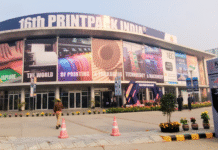
For the purpose of evaluating the recovery path of the Indian newspaper industry, Ipp Services, Training and Research (www.ippstar.org) has taken a look at the reported standalone financial results of a dozen publishers over the past five years from 1 April 2017 to 31 March 2022. The Covid-19 pandemic has been disruptive but the numbers show that the industry was plateauing even in FY 2017-18 and FY 2018-19 – years with seven bad quarters of GDP growth, as we entered the pandemic year and the full lockdown of FY 2020-21.
Nevertheless, on the basis of the subsequent hard financial results, one has to accept the view of Mathrubhumi publisher Shreyams Kumar that the news media has not yet recovered to its FY 2017-18 and FY 2018-19 levels. The decline shown by the sample of 12 publishers studied by IppStar (www.ippstar.org), began even before the pandemic, with their collective profits of over Rs 2,000 crore on a turnover of almost Rs. 18,300 crore in FY 2017-18, sinking by more than 61% in the FY 2018-19 year – a decline of over Rs. 1200 crore to less than Rs 800 crore.
While all the newspaper publishers in our sample were profitable in FY 2017-18, in the following 2018-19 financial year, two of them showed losses of more than Rs 100 crore. This predated the onset of the Covid-19 pandemic by 11 months and the 23 March 2020 lockdown by almost a full year.
In the following years, the number of loss-making news publishers in our sample increased to three and then four. In the most recent year for which we have data, FY 2021-22, only one company was still showing a loss, and that too of only Rs 20 crore. However, the combined profit of these companies in FY 21-22 has only reached 75% of that achieved four years ago, although it reflects a four-fold improvement over the previous year.
Profitability eroded by flat print ad spend & higher newsprint cost
The collective profit of these dozen publishers has increased from Rs. 346 crore to Rs. 1,510 crore or well over four times, in the FY 2021-22 that ended on 31 March 2022. Their collective total revenues have risen from Rs. 10, 934 crore to Rs. 13,544 crore in the same year, an increase of 23.9%.
In the same period, the cost of their material consumption which we can safely presume includes newsprint has increased by 41.7%, while their employee benefits and expenses have increased by only 3%. However, the monetary value of material consumption, including newsprint, is still almost 44% below FY 18-19, which given the much higher price of newsprint, indicates that the recovery in pagination and circulation is still far away.
The minimal increase in employee expenses in the latest full year for which we have data could be explained by the restoration of the 17.5% redundancies and wage cuts of journalists and other resources during FY 19-20 and FY 20-21. Although the employee and benefits expenses of publishers rose again in 21-22 by 3.1%, the data indicates that these expenses are still 15% below what they were four years ago. In the highly inflationary current situation, an implication may be that most of the editorial and operational redundancies have not been restored.
In the case of two publishers, the profits have actually fallen in their results in the most recent year we have accessed, over the previous year. And in the case of two other companies, although there is a slight increase in profit, the numbers are practically identical for the two years. This is largely explained by the over 40% increase in the cost of materials consumed by our sample, and the 3% increase in employee benefits – while circulation revenue increased by 11%, and ad revenues by 30%. In spite of ostensibly printing more copies and adding pagination compared to the previous year, the implication is that the landscape and scope of increasing advertising rates remain extremely competitive.
Tough years ahead, especially for smaller publishers
On the basis of published industry forecasts, one can expect an increase in print ad spending by 7.4% in FY 2022-23, and while circulation revenue may rise this is far from certain. One can anticipate and surmise that if the recovery continues and the combined advertising revenues of our sample increase by even 9%, (assuming that these publishers continue to cannibalize the market share of other print news publishers), these will still be 30% below their combined ad revenues in the 2017-18 and 2018-19 years. (In both these years, the ad revenues were flat, and almost identically, in the Rs. 12,700 to Rs 12,800 crore range.)
As to the profitability of our sample print news publishers, it may remain a challenge to achieve the combined Rs 2,000 crore profit of FY 2017-18 – an increase of 25% seems unlikely. For the rest of the industry, with notable exceptions, the profitability of the previous golden years is likely to be even further away since our sample seems to be increasing its share of the market and is representative enough to indicate that a larger sample will likely reinforce these findings.
A note on our sample
The newspaper and magazine publishers examined in the survey by IppStar include Amar Ujala in Hindi; Bartaman in Bengali and Hindi; Bennett & Coleman in English, Hindi, Bengali, Marathi, and Kannada; DB Corp in Hindi, Gujarati, and Marathi; HT Media in English; Hindustan Media Ventures in Hindi; Jagran Prakashan in Hindi and Urdu; Lokmat in Marathi; Mathrubhumi in Malayalam; Rajasthan Patrika in English and Hindi; Sandesh in Gujarati; and THG Publishing in English. Bartaman has only recently started its Hindi edition and the reported financial figures are likely to exclude its contribution. Similarly, the THG Publishing figures exclude the group’s associate entity which publishes its Tamil daily.
The print ad revenues of the dozen news organizations in our sample represented approximately 52% of the print advertising spend in India in FY 2020-21, and approximately 60% of the print ad spend in the country in FY 2021-22. Please note that in all cases we have taken the standalone financial results of these companies in an attempt to distinguish and filter these as best we can, from the distinct digital, outdoor signage, radio, television, and other business interests that many of them have.















